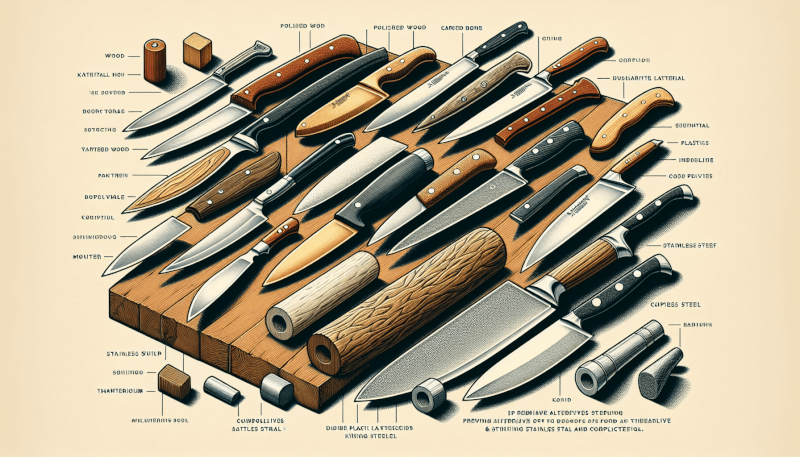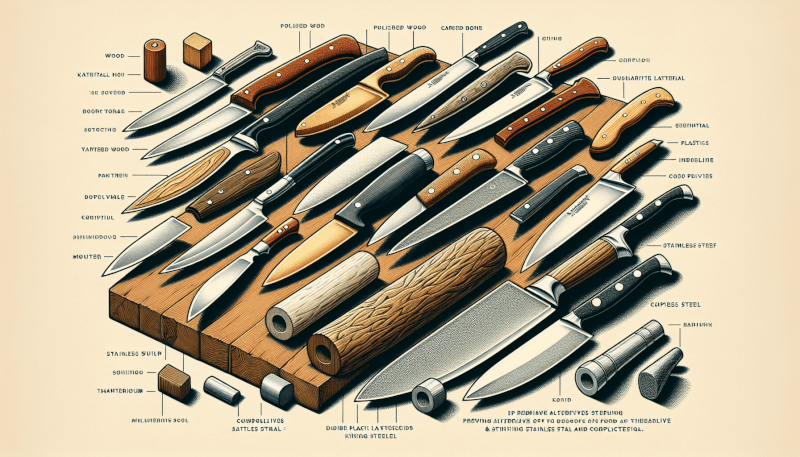In the world of kitchen knives, the handle material plays a crucial role in not only the overall aesthetics but also the functionality and comfort of the knife. From the timeless elegance of wooden handles to the durability of synthetic options like polypropylene, there are numerous handle materials to choose from. Each material brings its own set of benefits and considerations, ranging from heat resistance to grip stability. Whether you’re a professional chef or an avid home cook, understanding the different handle materials for kitchen knives will help you make an informed decision when selecting your next trusty kitchen tool.

Wood
Types of Wood Handles
Wood handles for kitchen knives come in various types, each with its unique characteristics. The most commonly used types include:
Rosewood: Known for its rich, reddish-brown color and attractive grain pattern, rosewood handles add a touch of elegance to any kitchen knife. They are durable and offer excellent grip.
Ebony: Highly sought after for its dark, luxurious appearance, ebony handles are known for their durability and resistance to moisture. They provide a comfortable grip and add a touch of sophistication to any kitchen knife.
Walnut: Walnut handles are prized for their warm, earthy tones and natural beauty. They are lightweight, making them comfortable to hold for extended periods. Walnut handles also provide a good grip and are resistant to cracking.
Bamboo: As an eco-friendly choice, bamboo handles have gained popularity in recent years. They offer a unique, natural aesthetic and are lightweight yet durable. Bamboo handles are also known for their resistance to moisture and stains.
Pros of Wood Handles
Wood handles offer several advantages for kitchen knives:
Natural Aesthetics: Wood handles add a touch of warmth and beauty to kitchen knives. They come in various colors and grain patterns, allowing you to choose one that complements your kitchen decor.
Comfortable Grip: Wood handles provide a comfortable grip, reducing strain and fatigue during prolonged use. The natural texture of wood enhances the knife’s balance and maneuverability.
Durable: When properly cared for, wood handles can last for years. They are resistant to impact, corrosion, and heat, making them suitable for everyday kitchen tasks.
Safe and Hygienic: Wood handles have natural antibacterial properties, minimizing the growth of harmful bacteria. They are non-reactive and do not transfer odors or flavors to the food being prepared.
Cons of Wood Handles
Despite their advantages, wood handles also have a few drawbacks to consider:
Maintenance: Wood handles require regular maintenance to keep them in optimal condition. They should be periodically oiled to prevent drying and cracking. Excessive exposure to water can damage the wood over time.
Susceptibility to Stains: Certain types of wood handles, such as lighter ones, may be prone to staining when exposed to highly pigmented foods or acidic substances. Prompt cleaning after use can help minimize staining.
Potential for Warping: Extreme changes in temperature or humidity can cause wood handles to warp or expand. Avoid exposing them to excessive heat or storing them in damp environments.
While wood handles bring natural beauty and comfort to kitchen knives, their maintenance requirements and susceptibility to damage under certain conditions should be considered before making a purchase.
Stainless Steel
Types of Stainless Steel Handles
Stainless steel handles offer a sleek and modern look to kitchen knives. Various types of stainless steel handles are available, including:
Solid Stainless Steel: Handles made entirely of stainless steel provide a seamless and uniform appearance. They are known for their strength, durability, and resistance to corrosion.
Stainless Steel with Inlay: Some stainless steel handles feature inlaid designs or patterns, adding visual interest and personalization. This type of handle combines the benefits of stainless steel with enhanced aesthetics.
Stainless Steel Bolster: A bolster is a thick portion of the blade near the handle. Kitchen knives may have stainless steel bolsters that provide additional stability and balance. These handles offer a comfortable grip and a professional look.
Pros of Stainless Steel Handles
Stainless steel handles come with several advantages:
Sleek and Modern Design: Stainless steel handles have a timeless appeal, adding a sophisticated touch to any kitchen. Their shiny, reflective surface enhances the overall aesthetics of the knife.
Easy to Clean: Stainless steel handles are non-porous, making them resistant to stains and odors. They can be easily wiped clean with a damp cloth or washed with mild soap and water.
Durable and Hygienic: Stainless steel handles are exceptionally durable, withstanding frequent use and exposure to moisture. They are non-reactive and do not corrode, ensuring optimal hygiene in the kitchen.
Lightweight and Well-Balanced: The weight of stainless steel handles contributes to the knife’s overall balance, allowing for precise control and effortless maneuverability during various cutting tasks.
Cons of Stainless Steel Handles
Despite their many advantages, stainless steel handles also have a few drawbacks:
Heat Conductivity: Stainless steel is a good conductor of heat, which can be a disadvantage when handling hot ingredients or using the knife for prolonged periods. Insulating materials may be required to prevent discomfort or burns.
Less Grip: Compared to other handle materials, stainless steel handles may be less grippy, especially when wet. Textural features or finger grooves may be added to enhance grip, but they may not be as effective as other materials.
May Feel Cold: Stainless steel handles can feel cold to the touch, especially in colder climates or during winter months. Some individuals may find this uncomfortable, although it is a subjective preference.
When considering stainless steel handles, the sleek design, durability, and easy maintenance should be balanced with potential concerns regarding heat conductivity and grip.

Plastic
Types of Plastic Handles
Plastic handles for kitchen knives come in a variety of materials, offering different levels of durability and aesthetics. Some common types of plastic handles include:
Polypropylene (PP): Polypropylene handles are lightweight, durable, and resistant to impact. They offer a comfortable grip and come in various colors.
ABS (Acrylonitrile Butadiene Styrene): ABS handles are known for their excellent impact resistance and durability. They have a glossy appearance and are available in a wide range of colors.
Fiberglass Reinforced Nylon: Handles made from fiberglass reinforced nylon are exceptionally strong, resistant to heat, and provide a secure grip. They are often textured to enhance grip even further.
Pros of Plastic Handles
Plastic handles provide several benefits for kitchen knives:
Affordable: Plastic handles are generally more affordable compared to other materials, making them a budget-friendly option.
Lightweight: Plastic handles are lightweight, which can be beneficial for reducing fatigue during prolonged use.
Durable and Low Maintenance: Plastic handles are resistant to impact, heat, and corrosion. They are easy to clean and do not require extensive maintenance.
Wide Range of Colors and Styles: Plastic handles offer a wide variety of color and style options, allowing for personalization and complementing various kitchen decors.
Cons of Plastic Handles
While plastic handles have their advantages, they also have some limitations to consider:
Lower Aesthetic Appeal: Plastic handles may not provide the same level of visual appeal as natural materials like wood or the sleekness of stainless steel. However, this is subjective and depends on personal preference.
Potential for Wear and Tear: Over time, plastic handles may show signs of wear, such as scratches or fading. Excessive exposure to heat or sharp objects can accelerate this wear and tear.
Less Insulative: Plastic handles may not provide as much insulation against heat as other materials. It is essential to exercise caution when handling hot ingredients or exposing the knife to high temperatures.
When considering plastic handles, affordability, durability, and low maintenance should be weighed against potential concerns about aesthetic appeal and insulation capabilities.
Carbon Fiber
Properties of Carbon Fiber Handles
Carbon fiber handles offer a unique combination of strength and lightweight design. Some notable properties of carbon fiber handles include:
High Strength-to-Weight Ratio: Carbon fiber handles are incredibly strong while maintaining a lightweight profile. This property makes them highly desirable for those seeking both durability and reduced knife weight.
Excellent Rigidity: Carbon fiber handles exhibit exceptional rigidity, providing stability and precision during cutting tasks. The rigid nature of carbon fiber also ensures the knife retains its shape and improves overall durability.
Resistance to Heat and Chemicals: Carbon fiber handles have excellent resistance to both high temperatures and a wide range of chemicals. This makes them suitable for use in professional kitchens where heat and chemical exposure are common.
Pros of Carbon Fiber Handles
Carbon fiber handles offer numerous advantages:
Strength and Durability: Carbon fiber handles are known for their exceptional strength, ensuring longevity and withstanding heavy use. They are resistant to impact, chipping, and cracking.
Lightweight: Carbon fiber handles are significantly lighter than many other materials, reducing user fatigue during extended use. This makes them ideal for delicate cutting tasks that require precision.
Aesthetically Pleasing: The unique woven pattern of carbon fiber handles exudes a modern and high-end aesthetic. The distinct appearance of carbon fiber adds a touch of sophistication to any kitchen knife.
Resistance to Wear and Corrosion: Carbon fiber handles do not succumb easily to wear and tear. They are resistant to corrosion, making them ideal for use in a variety of environments.
Cons of Carbon Fiber Handles
Despite their numerous advantages, there are a few downsides to using carbon fiber handles:
Higher Cost: Carbon fiber handles tend to be more expensive compared to traditional handle materials. The intricate manufacturing process and the high-quality raw materials contribute to the higher cost.
Can Feel Stiff: The rigidity that makes carbon fiber handles desirable for stability and durability can also lead to a stiffer feel when compared to other handle materials. Some users may prefer a more flexible handle.
While carbon fiber handles offer exceptional strength and lightweight design, the higher cost and potentially stiffer feel should be considered when choosing this material for kitchen knives.

G-10
What is G-10?
G-10 is a composite material commonly used for knife handles. It is made by layering fiberglass cloth soaked in epoxy resin and compressing them under high pressure. The resulting material is strong, lightweight, and resistant to moisture and chemicals.
Pros of G-10 Handles
G-10 handles offer several advantages for kitchen knives:
Superior Durability: G-10 handles are exceptionally durable and can withstand heavy use. They are resistant to impact, chipping, and cracking, making them ideal for demanding kitchen tasks.
Excellent Grip: G-10 handles have a textured surface that provides a secure and comfortable grip. Even when wet, the grip remains firm, enhancing safety during cutting.
Moisture and Chemical Resistance: G-10 handles are resistant to moisture, ensuring they do not absorb water or warp over time. They are also resistant to various chemicals commonly found in the kitchen, maintaining their integrity.
Wide Range of Colors and Designs: G-10 handles come in a variety of colors and designs, allowing for customization and personalization. This provides an opportunity to match the handle to individual style or kitchen decor.
Cons of G-10 Handles
While G-10 handles have many advantages, they also have a few drawbacks to consider:
Potential for Cold Feel: G-10 handles can feel cold to the touch, similar to stainless steel. Some individuals may find this uncomfortable, particularly in colder climates or during winter months.
Can Be Relatively Hard: G-10 handles may feel harder compared to other handle materials. Some users may prefer a softer or more flexible feel during prolonged use.
G-10 handles offer exceptional durability, grip, and resistance to moisture and chemicals. However, individuals sensitive to cold handles or desiring a softer feel should take these factors into account.
Micarta
What is Micarta?
Micarta is a composite material made from layers of fabric, such as linen or canvas, impregnated with epoxy resin. The layers are compressed under high pressure, resulting in a dense and sturdy material.
Pros of Micarta Handles
Micarta handles offer several advantages for kitchen knives:
Superior Strength and Durability: Micarta handles are renowned for their excellent strength and durability. They can withstand heavy use and are resistant to impact, chipping, and cracking.
Excellent Grip: Micarta handles have a textured surface that provides a secure and comfortable grip. The texture ensures a firm hold, even when the handle is wet or greasy, enhancing safety during use.
Resistance to Moisture: Micarta handles are resistant to moisture, ensuring they do not warp or degrade over time. This property makes them suitable for use in humid kitchen environments.
Aesthetic Appeal: Micarta handles come in a variety of colors and patterns, adding visual interest to any kitchen knife. With micarta, you can find a handle style that aligns with your personal taste and kitchen decor.
Cons of Micarta Handles
While micarta handles have numerous advantages, there are a few considerations to keep in mind:
Potential for Cold Feel: Similar to other dense materials like stainless steel or G-10, micarta handles can feel cold to the touch. This may be uncomfortable for some individuals, especially in colder climates or during winter months.
May Require Regular Maintenance: Depending on the specific type of micarta, some handles may require occasional oiling or waxing to prevent drying and maintain their appearance. Regular cleaning should also be done to remove any food particles or debris from the handle’s texture.
Micarta handles offer exceptional strength, grip, and resistance to moisture. However, individuals sensitive to cold handles or those not inclined to perform occasional maintenance may prefer other handle materials.

Bone
Types of Bone Handles
Bone handles for kitchen knives are available in various types, each offering its unique characteristics:
Stabilized Bone: Stabilized bone handles undergo a stabilization process to enhance their strength and durability. This treatment minimizes the risk of cracking or splitting, making the handles more suitable for everyday use.
Cow Bone: Cow bone handles provide a classic and traditional aesthetic. They have a smooth surface and often feature natural variations in color and pattern.
Buffalo Horn: Buffalo horn handles are known for their natural beauty and unique grain patterns. They offer an exquisite touch to any kitchen knife, providing elegance and sophistication.
Pros of Bone Handles
Bone handles offer several advantages for kitchen knives:
Traditional and Timeless Aesthetic: Bone handles have a classic appeal that can add a touch of tradition to any kitchen. Their natural variations in color and grain patterns make each handle unique.
Excellent Durability: When properly cared for, bone handles can be highly durable. Stabilized bone handles, in particular, are resistant to cracking and splitting, ensuring longevity with regular use.
Grippy Surface: Bone handles have a natural texture that provides a secure grip. This enhances safety during cutting tasks, even when the handle is wet or greasy.
Resistance to Moisture: Bone handles are resistant to moisture, minimizing the risk of warping or degrading over time. The natural structure of bone helps maintain its integrity.
Cons of Bone Handles
Despite their advantages, bone handles also have a few potential drawbacks:
Potential for Staining: Bone handles, especially lighter-colored ones, may be prone to staining when exposed to highly pigmented foods or acidic substances. Prompt cleaning after use can help minimize staining.
Maintenance Requirements: Bone handles require regular maintenance to keep them in optimal condition. They should be periodically cleaned, polished, and treated with wax or oil to prevent drying or discoloration.
Bone handles bring a timeless and traditional aesthetic, excellent durability, and a grippy surface to kitchen knives. However, potential concerns regarding staining and maintenance should be considered before choosing this handle material.
Horn
Types of Horn Handles
Horn handles for kitchen knives are available in various types, each with its unique characteristics:
Buffalo Horn: Buffalo horn handles offer a striking natural beauty, with variations in color and grain patterns that make each handle unique. They provide a comfortable grip and add a touch of elegance to any kitchen knife.
Stag Horn: Stag horn handles are renowned for their rugged and rustic appearance. They feature a distinct texture and coloration, adding a touch of natural charm to any kitchen knife.
Pros of Horn Handles
Horn handles offer several advantages for kitchen knives:
Unique Aesthetic: Horn handles have a distinctive natural appearance, and no two handles are the same. This uniqueness adds a touch of exclusivity and individuality to the knife.
Comfortable Grip: Horn handles provide a comfortable grip, ensuring optimal control and reducing strain during cutting tasks. The textured surface of the horn enhances the grip, even when wet or greasy.
Durability: Horn handles are remarkably durable and can withstand frequent use. When properly cared for, they have excellent resistance to impact and chipping.
Cons of Horn Handles
While horn handles have many advantages, they also have a few limitations to consider:
Maintenance Requirements: Horn handles require regular maintenance to keep them in optimal condition. They should be periodically cleaned, polished, and treated with wax or oil to prevent drying or discoloration.
Potential for Odor: Some individuals may find that horn handles have a slight odor initially. However, with proper cleaning and maintenance, any odor should dissipate over time.
Horn handles bring natural beauty, a comfortable grip, and durability to kitchen knives. However, the maintenance requirements and potential initial odor should be considered before choosing this handle material.

Stag
Types of Stag Handles
Stag handles for kitchen knives are available in various forms, each offering its unique characteristics:
Red Stag: Red stag handles come from deer antlers and are prized for their exceptional natural beauty. They provide a comfortable grip and add a touch of rustic charm to any kitchen knife.
Sambar Stag: Sambar stag handles come from the sambar deer and are known for their durability and attractive grain patterns. They offer a comfortable and secure grip for precise cutting.
Pros of Stag Handles
Stag handles offer several advantages for kitchen knives:
Natural Beauty: Stag handles have a unique and rustic aesthetic that adds character to any knife. Each handle boasts natural variations and patterns, making it one-of-a-kind.
Comfortable Grip: Stag handles provide a comfortable and secure grip, enhancing control and reducing strain during cutting tasks. The texture of the stag enhances the grip, even when wet or greasy.
Durable: Stag handles are highly durable and can withstand heavy use. When properly cared for, they offer excellent resistance to impact and chipping.
Cons of Stag Handles
While stag handles have many advantages, they also have a few considerations:
Maintenance Requirements: Stag handles require regular maintenance to keep them in optimal condition. They should be periodically cleaned, polished, and treated with wax or oil to prevent drying or discoloration.
Ethical Considerations: Stag handles raise ethical concerns for those who prioritize animal welfare. Given that stag handles are derived from deer antlers, individuals sensitive to animal rights may opt for alternative handle materials.
Stag handles bring natural beauty, a comfortable grip, and durability to kitchen knives. However, the maintenance requirements and ethical considerations should be taken into account when choosing this handle material.
Rubber
Pros of Rubber Handles
Rubber handles offer several advantages for kitchen knives:
Excellent Grip: Rubber handles provide a high degree of grip, ensuring safe and precise cutting. The soft and grippy texture of rubber enhances control, even when the handle is wet or greasy.
Comfortable and Ergonomic: Rubber handles are typically designed with ergonomics in mind, offering a comfortable grip for reduced hand fatigue during extended use.
Shock Absorption: Rubber handles have inherent shock-absorbing properties, reducing strain on the user’s hands and wrists when performing heavy-duty cutting tasks.
Resistance to Water and Chemicals: Rubber handles are resistant to water, making them suitable for wet kitchen environments. They are also resistant to various chemicals commonly encountered in the kitchen.
Cons of Rubber Handles
While rubber handles have many advantages, they also have a few considerations:
Potential for Odor: Some individuals may find that rubber handles have a noticeable odor initially. However, the odor typically dissipates over time, especially with regular cleaning.
Durability: Depending on the specific rubber used, some rubber handles may not be as durable as other handle materials. They may show signs of wear over time, such as cracking or splitting.
Rubber handles bring excellent grip, comfort, and shock absorption to kitchen knives. However, potential concerns regarding initial odor and long-term durability should be considered when choosing this handle material.
Overall, the choice of handle material for kitchen knives depends on personal preference, intended use, and maintenance considerations. Whether you prioritize natural aesthetics, durability, or specific handling characteristics, there is a handle material to suit your needs. Consider the pros and cons of each material before making your decision, and you’ll find the perfect handle that enhances your culinary experience. Happy cooking!


